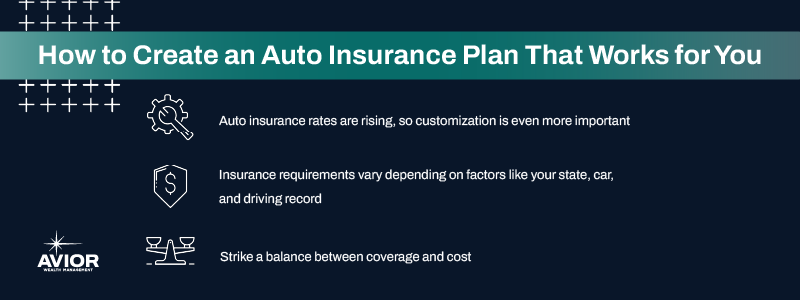How to Create an Auto Insurance Plan That Works for You
The more you understand your options, the better your policy will be.

Auto insurance is a necessary part of car ownership, but determining exactly what plan is right for you is an all-too-familiar challenge to many drivers. Some are overinsured, paying too much for services or coverage they don’t need. Others are underinsured, which can deliver quite a shock when bills come due after an accident.
It’s more important than ever to customize your auto insurance plan, as rates continue to rise. Drivers in the U.S. pay an average of $2,543 per year, or $212 per month, up 26% from 2023. If you earn the national median household income ($74,580), that takes 3.41% of your yearly earnings.
Below, we provide a set of best practices to craft an auto insurance plan that fits your specific vehicle, driving habits, and potential risks. You will be able to understand and choose coverage options that fit the needs of you and your family, allowing you to head out on the open road with confidence.
Identify your insurance needs
Picking the ideal auto insurance policy means striking a balance between what you need versus how much you’re willing to pay. But how do you know what you actually need? There are a few basic steps – figure out how much coverage is the right amount, how much deductible you can afford, and what carrier can provide all of this.
Your policy should have a healthy balance of cost and coverage. You’ll need to have a clear picture of your assets to know how much liability coverage is appropriate. Too little, and you may go over your limits in the event of an accident. If you have ample liquid assets available in the bank, it may be worth opting for a higher deductible. An out-of-pocket upfront cost of $1,500 can mean lower premiums in years to come.
It’s also worth considering whether you’ll want insurance to help with minor repairs of, say, $500, in addition to covering potential accident costs. If so, then it pays to keep your deductible lower to allow for this flexibility.
The value of the vehicle is also an important factor. The older the car, the lower its potential payout value, which might not require as much coverage. A $1,500 deductible on a car that’s 16 years old and worth $3,750 will only bring $2,250 if it’s in a serious accident. Better to pay for comprehensive and collision coverage every month and put the extra money toward a new car.
Understand your coverage options
Most auto insurance policies contain a standard set of coverage options. Some are required, others are not, largely depending on where you live. Once you’re familiar with them, you’ll be able to pick the policy that fits your needs.
There are six types of auto insurance:
- Bodily injury liability. This pays expenses for another person if you are at fault in an accident that causes them injury. All states except Florida require it. This coverage pays for medical expenses, pain and suffering, and lost wages.
- Property damage liability. This pays for another person’s vehicle or other property that is damaged in an accident where you are at fault. “Other property” can refer to fences, walls, and equipment, including mailboxes.
- Personal injury protection (or medical payments). This covers any medical bills that apply to you and/or a passenger in your vehicle after an accident. These payments can lower the bill that goes to your health insurance provider. This coverage can also help replace lost wages if someone is unable to work because of the accident, or funeral expenses if someone passes away due to the accident. Twelve states currently require this type of coverage.
- Collision. This covers damage to your own vehicle or property, which can include hitting a stationary object or another vehicle. Collision is optional in every state, but, if you have a loan on the car, the lender might require it.
- Comprehensive. This pays for incidents that are the result of something other than a collision with another vehicle or object. Examples include theft, fire, natural disasters, extreme weather, or damage caused by an animal encounter. Like collision, no states require it, but lenders might.
- Underinsured/uninsured motorist. If you’re in an accident where the other driver doesn’t have enough insurance, or any insurance at all, this type of coverage can protect you. It can pay for vehicle repairs or medical bills. If your state has a high number of underinsured or uninsured drivers, then this coverage might be worth considering.
Additional forms of coverage may include coverage for roadside assistance or the purchase of a new car, towing and labor insurance, and reimbursement for a rental car.
Weigh the factors
Different drivers pay different amounts for auto insurance. There are many factors that can change your rate, such as details about the vehicle or your personal information. Here’s a brief word on each and what you can do to lower your rate.
- The car. Some cars – such as BMW, Dodge, and Tesla – are more expensive to insure than others – such as Subaru, Volkswagen, and Mazda. If your car has built-in security, like an anti-theft device, that can lower your premiums.
- Your driving record. The more accidents in your past, the higher your rate will be. Also, if you’re a newer driver, your rate will probably be more.
- Your driving habits. The more you drive, the more you may pay for insurance. More miles on the road means more potential for risk.
- Where you live (and park). Urban neighborhoods often have more accidents, vandalism, and theft and therefore tend to have higher premiums.
- Your gender and age. Men are statistically more likely to get into accidents, so their rates tend to be higher than women. And younger drivers, or drivers with less experience, also pay more.
There are ways to lower your insurance bill above and beyond those listed here. There are discounts for low mileage, good driver, multi-car family, anti-theft, and new cars, among others.
Balance coverage and cost
It’s essential to shop around when buying car insurance, as different companies offer different kinds of policies. Be sure to keep an eye on premiums and deductibles so you can accurately compare costs. It’s also worth remembering that the minimum coverage limits are just a starting point. In many situations, it behooves you to purchase coverage above the minimum. While it may drive up your premiums, buying additional coverage can save you a significant amount should you be in an accident.
Trust Avior with auto insurance planning
While paying for auto insurance can seem like a nuisance, the money will be a smart investment should you get in an accident. To pick the best policy for your personal situation, it’s important to remember the types of coverage and reputation of the firm offering them. Even if you’re happy with your policy, it’s important to review it regularly and make the necessary adjustments to keep it cost-effective and strong.
Our team at Avior Wealth Management is comprised of experts in insurance, including automotive coverage. If you’re ready to take the first step, reach out to schedule a one-on-one consultation.
Disclaimer: Nothing contained herein should be construed as legal or tax advice. Avior and our Advisors will work with your attorney and/or tax professional to assist with your legal and tax strategies. Please consult your attorney or tax professional with specific legal and/or tax questions. Investment Management and Financial Planner are offered through Avior Wealth Management, LLC, an SEC-registered investment advisor. Past performance is not a guarantee of future results. Investments are subject to loss, including the loss of principal.
No Comments
Sorry, the comment form is closed at this time.




